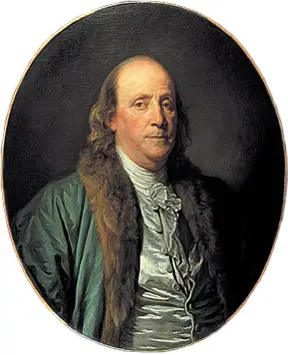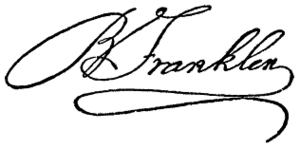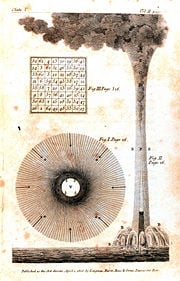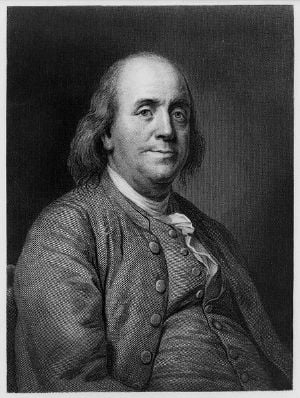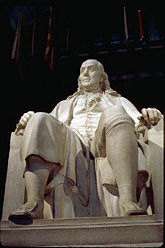Benjamin Franklin
Benjamin Franklin (January 17, 1706 – April 17, 1790) was born in Boston, Massachusetts, to a tallow-maker. He became a newspaper editor, printer, merchant, and philanthropist in Philadelphia, Pennsylvania. He was one of the most prominent of Founders and early political figures and statesmen of the United States. As a "self-made man" noted for his curiosity, ingenuity, generosity, and diversity of interests, he became an inspiration and model for many early Americans. As a broad-minded thinker and political leader able to embrace all Americans, he was a source of unification of colonial society and the United States. As a philosopher and scientist, who had discovered electricity, he was at one point the most famous man in Europe. As a statesman in London before the Revolution, and Minister to France during the Revolution, he defined the new nation in the minds of Europe. His success in securing French military and financial aid, and recruiting military leaders in Europe was decisive for the American victory over Britain.
He published the famous Poor Richard's Almanack and Pennsylvania Gazette. He organized the first public lending library and fire department in America, the Junto, a political discussion club, the American Philosophical Scoiety, and public schools.
He became a national hero in America when he convinced Parliament to repeal the hated Stamp Act. A diplomatic genius, Franklin was almost universally admired among the French as American minister to Paris, and was a major figure in the development of positive Franco-American relations. From 1775 to 1776, Franklin was Postmaster General under the Continental Congress and from 1785 to his death in 1790 was President of the Supreme Executive Council of Pennsylvania.
Franklin was interested in science and technology, carrying out his famous electricity experiments and invented the Franklin stove, medical catheter, lightning rod, swimfins, glass harmonica, and bifocals. He also played a major role in establishing the higher education institutions that would become the Ivy League's University of Pennsylvania and the Franklin and Marshall College. In addition, Franklin was a noted linguist, fluent in five languages, including Greek and Latin. Towards the end of his life, he became one of the most prominent early American abolitionists. Today Franklin is pictured on the U.S. $100 bill.
Biography
Ancestry
Franklin's father, Josiah Franklin, was born at Ecton, Northamptonshire, England on December 23, 1657, the son of Thomas Franklin, a blacksmith and farmer, and Jane White. His mother, Abiah Folger, was born in Nantucket, Massachusetts on August 15, 1667, to Peter Folger, a miller and schoolteacher, and his wife Mary Morrill, a former indentured servant.
Around 1677, Josiah married Anne Child at Ecton, and over the next few years had three children. These half-siblings of Benjamin Franklin included Elizabeth (March 2 1678), Samuel (May 16, 1681), and Hannah (May 25, 1683).
Sometime during the second half of 1683, the Franklins left England for Boston, Massachusetts. While in Boston, they had several more children, including Josiah Jr. (August 23, 1685), Ann (January 5, 1687), Joseph (February 5, 1688), and Joseph (June 30, 1689) (the first Joseph having died soon after birth).
Josiah's first wife Anne died in Boston on July 9, 1689. He was later remarried to a woman called Abiah on November 25 1689 in the Old South Church of Boston by the Rev. Samuel Willard.
They had the following children: John (December 7, 1690), Peter (November 22, 1692), Mary (September 26, 1694), James (February 4, 1697), Sarah (July 9, 1699), Ebenezer (September 20, 1701), Thomas (December 7, 1703), Benjamin (January 17, 1706), Lydia (August 8, 1708), and Jane (March 27, 1712).
Early life
Benjamin Franklin was born on Milk Street in Boston, Massachusetts on January 17, 1706. His father, Josiah Franklin, was a tallow chandler, a maker of candles and soap, who married twice. Josiah's marriages produced 17 children; Benjamin was the tenth and youngest son. He attended Boston Latin School but did not graduate. His schooling ended at ten and at 12 he became an apprentice to his brother James, a printer who published the New England Courant, the first truly independent newspaper in the colonies. While a printing apprentice, he wrote under the pseudonym of 'Silence Dogood' who was ostensibly a middle-aged widow. His brother and the Courant's readers did not initially know the real author. James was not impressed when he discovered his popular correspondent was his younger brother. Franklin left his apprenticeship without permission and in so doing became a fugitive.
At the age of 17, Franklin ran away to Philadelphia, seeking a new start in a new city. When he first arrived he worked in several printer shops around town. However, he was not satisfied by the immediate prospects. After a few months, while working in a printing house, Franklin was induced by Pennsylvania Governor Sir William Keith to go to London, ostensibly to acquire the equipment necessary for establishing another newspaper in Philadelphia. Finding Keith's promises of backing a newspaper to be empty, Franklin worked as a compositor in a printer's shop in what is now the Church of St Batholomew the Great, Smithfield. Following this, he returned to Philadelphia in 1726 with the help of a merchant named Thomas Denham, who gave Franklin a position as clerk, shopkeeper, and bookkeeper in Denham's merchant business.
Upon Denham's death, Franklin returned to his former trade. By 1730, Franklin had set up a printing house of his own and had contrived to become the publisher of a newspaper called "The Pennsylvania Gazette". The Gazette gave Franklin a forum for agitation about a variety of local reforms and initiatives through printed essays and observations. Over time, his commentary, together with a great deal of savvy about cultivating a positive image of an industrious and intellectual young man, earned him a great deal of social respect.
Franklin established a common law marriage with a woman named Deborah Read in September, 1730, with whom he eventually had two children, Francis and Sarah. In 1724, while a boarder in her mother's home, Franklin had courted Deborah before going to London at Governor Keith's behest. At that time, Miss Read's mother was somewhat wary of allowing her daughter to wed a seventeen-year old who was on his way to London. Her own husband having recently died, Mrs. Read declined Franklin's offer of marriage.
While Franklin was finding himself in London, Deborah married a man named John Rodgers. This proved to be a regrettable decision. Rodgers shortly avoided his debts and prosecution by fleeing to Barbados, leaving Deborah behind. With Rodgers' fate unknown, and bigamy an offense punishable by public whipping and imprisonment, Deborah was not free to remarry.
Franklin himself had his own actions to ponder. During 1730, Franklin acknowledged an illegitimate son named William, who eventually became the last Loyalist governor of New Jersey. While the identity of William's mother remains unknown, perhaps the responsibility of an infant child gave Franklin a reason to take up residence with Deborah Read. In any event, William eventually broke with his father over the treatment of the colonies at the hands of the crown, but was not above using his father's notoriety to enhance his own standing.
At a time when many colonial families consisted of six or more children, Benjamin and Deborah Franklin eventually had two. The first was Francis Folger Franklin, born October 1732. In one of the most painful moments of Franklin's life, the boy died of smallpox in the fall of 1736. A daughter, Sarah Franklin, was born in 1743. She eventually married a man named Richard Bache, had seven children, and cared for her father in his old age.
In 1733, Franklin began to issue the famous Poor Richard's Almanack (with content both original and borrowed) on which much of his popular reputation is based. Adages from this almanac such as "A penny saved is twopence clear" (often misquoted as "A penny saved is a penny earned") and "Fish and visitors stink in three days" remain common quotations in the modern world.He sold about ten thousand copies a year.
Franklin and several other members of a philosophical association joined their resources in 1731 and began the first public library in Philadelphia. The newly founded Library Company ordered its first books in 1732, mostly theological and educational tomes, but by 1741 the library also included works on history, geography, poetry, exploration, and science. The success of this library encouraged the opening of libraries in other American cities, and Franklin felt that this enlightenment partly contributed to the American colonies' struggle to maintain their privileges.
In 1736 he created the Union Fire Company, the first volunteer firefighting company in America.
Middle years
As he matured, Franklin began to concern himself more with public affairs. In 1743, he set forth a scheme for The Academy and College of Philadelphia. He was appointed President of the Academy in November 13 1749, and it opened on August 13 1751. At its first commencement, on May 17, 1757, seven men graduated; six with a Bachelor of Arts and one as Master of Arts. It was later merged with the University of the State of Pennsylvania, to become the University of Pennsylvania, today a member of the Ivy League. He founded the American Philosophical Society to help scientific men discuss their discoveries. He began the electrical research that, along with other scientific inquiries, would occupy him for the rest of his life (in between bouts of politics and money-making).
In 1748, he retired from printing and went into other businesses. He created a partnership with his foreman, David Hill, which provided Franklin with half of the shop's profits for 18 years. This lucrative business arrangement provided leisure time for study, and in a few years he had made discoveries that gave him a reputation with the learned throughout Europe and especially in France.
These include his investigations of electricity. Franklin proposed that "vitreous" and "resinous" electricity were not different types of "electrical fluid" (as electricity was called then), but the same electrical fluid under different pressures (See electrical charge). He is also often credited with labeling them as positive and negative respectively. In 1750, he published a proposal for an experiment to prove that lightning is electricity by flying a kite in a storm that appeared capable of becoming a lightning storm. On May 10, 1752, Thomas Francois d'Alibard of France conducted Franklin's experiment (using a 40-foot-tall iron rod instead of a kite) and extracted electrical sparks from a cloud. On June 15, Franklin conducted his famous kite experiment and also successfully extracted sparks from a cloud (unaware that d'Alibard had already done so, 36 days earlier). Franklin's experiment was not written up until Joseph Priestley's 1767 History and Present Status of Electricity; the evidence shows that Franklin was insulated (not in a conducting path, as he would have been in danger of electrocution in the event of a lightning strike). (Others, such as Prof. Georg Wilhelm Richmann of St. Petersburg, Russia, were spectacularly electrocuted during the months following Franklin's experiment.) In his writings, Franklin indicates that he was aware of the dangers and offered alternative ways to demonstrate that lightning was electrical, as shown by his invention of the lightning rod, an application of the use of electrical ground. If Franklin did perform this experiment, he did not do it in the way that is often described (as it would have been dramatic but fatal). Instead he used the kite to collect some electric charge from a storm cloud, which implied that lightning was electrical. See, for example, the 1805 painting by Benjamin West of Benjamin Franklin drawing electricity from the sky.
In recognition of his work with electricity, Franklin was elected a Fellow of the Royal Society and received its Copley Medal in 1753. The cgs unit of electric charge has been named after him: one franklin (Fr) is equal to one statcoulomb.
Franklin established two major fields of physical science, electricity and meteorology. In his classic work (A History of The Theories of Electricity & Aether), Sir Edmund Whittaker (p. 46) refers to Franklin's inference that electric charge is not created by rubbing substances, but only transferred, so that "the total quantity in any insulated system is invariable." This assertion is known as the "principle of conservation of charge."
As a printer and a publisher of a newspaper, Franklin frequented the farmers' markets in Philadelphia to gather news. One day Franklin inferred that reports of a storm elsewhere in Pennsylvania must be the storm that visited the Philadelphia area in recent days. This initiated the notion that some storms travel, eventually leading to the synoptic charts of dynamic meteorology, replacing sole dependence upon the charts of climatology.
In 1751, Franklin and Dr. Thomas Bond obtained a charter from the Pennsylvania legislature to establish a hospital. Pennsylvania Hospital was the first hospital in what was to become the United States of America.
In politics he proved very able, both as an administrator and as a controversialist. As an office-holder, he made use of his position to advance his relatives, though doing so was all but expected in a world dominated by political patronage. His most notable service in domestic politics was his reform of the postal system, but his fame as a statesman rests chiefly on his diplomatic services in connection with the relations of the colonies with Great Britain, and later with France. It was during this period that Franklin was involved in the creation of not only the aforementioned first volunteer fire department and free public library, but also many other civic enterprises.
In 1754 he headed the Pennsylvania delegation to the Albany Congress. This meeting of several colonies had been requested by the Board of Trade in England to improve relations with the Indians and defense against the French. Franklin proposed a broad Plan of Union for the colonies. While the plan was not adopted, elements of it found their way into the Articles of Confederation and the Constitution.
In 1757 he was sent to England to protest against the influence of the Penn family in the government of Pennsylvania, and for five years he remained there, striving to enlighten the people and the ministry of the United Kingdom of colonial conditions. At the Oxford University, Franklin was awarded an honorary doctorate for his scientific accomplishments and from then on went by "Doctor Franklin." He also managed to secure a post for his illegitimate son, William Franklin, as Colonial Governor of New Jersey.
In 1756, Franklin became a member of the Society for the Encouragement of Arts, Manufactures & Commerce (now Royal Society of Arts or RSA, which had been founded in 1754), whose early meetings took place in coffee shops in London's Covent Garden district, close to Franklin's main residence in Craven Street (the only one of his residences to survive and which is currently undergoing renovation and conversion to a Franklin museum). After his return to America, Franklin became the Society's Corresponding Member and remained closely connected with the Society. The RSA instituted a Benjamin Franklin Medal in 1956 to commemorate the 250th anniversary of Franklin's birth and the 200th anniversary of his membership of the RSA.
In 1758, the year in which he ceased writing for the Almanac, he printed "Father Abraham's Sermon," one of the most famous pieces of literature produced in Colonial America.
Franklin noted a principle of refrigeration by observing that on a very hot day, he stayed cooler in a wet shirt in a breeze than he did in a dry one. To understand this phenomenon more clearly Franklin conducted experiments. On one warm day in Cambridge England in 1758, Franklin and fellow scientist John Hadley experimented by continually wetting the ball of a mercury thermometer with ether and using bellows to evaporate the ether. With each subsequent evaporation, the thermometer read a lower temperature, eventually reaching 7 °F (-14 °C). Another thermometer showed the room temperature to be constant at 65 °F (18 °C). In his letter “Cooling by Evaporation,” Franklin noted that “one may see the possibility of freezing a man to death on a warm summer’s day.”
Later years
On his return to America (1762), Franklin played an honorable part in the Paxton affair, through which he lost his seat in the Assembly. But in 1764, he was again dispatched to England as agent for the colony, this time to petition the King to resume the government from the hands of the proprietors. In London, he actively opposed the proposed Stamp Act, but lost the credit for this and much of his popularity because he secured for a friend the office of stamp agent in America. This perceived conflict of interest, and the resulting outcry, is widely regarded as a deciding factor in Franklin's never achieving higher elected office. Even his effective work in helping to obtain the repeal of the act did not regain his popularity, but he continued his efforts to present the case for the Colonies as the troubles escalated toward the crisis which would result in the Revolution. This also led to an irreconcilable conflict with his son, who remained ardently loyal to the British Government.
In September 1767, he visited Paris, France, where he was received with honor.
While living in London in 1768, he developed a Phonetic alphabet in A Scheme for a new Alphabet and a Reformed Mode of Spelling. This reformed alphabet discarded six letters Franklin regarded as redundant, and substituted six new letters for sounds he felt lacked letters of their own; however, his new alphabet never caught on and he eventually lost interest. [1]
Before his return home in 1775, he lost his position as postmaster through his share in divulging to Massachusetts the famous letter of Hutchinson and Oliver. On his arrival in Philadelphia he was chosen as a member of the Continental Congress, and assisted in editing the Declaration of Independence.
In December of 1776, he was dispatched to France as commissioner for the United States. He lived in a home in the Parisian suburb of Passy donated by Jacques-Donatien Le Ray de Chaumont who would become a friend and the most important foreigner to help the United States win the War of Independence. Franklin remained in France until 1785, and was such a favorite of French society that it became fashionable for wealthy French families to decorate their parlors with a painting of him. He conducted the affairs of his country towards that nation with great success, including securing a critical military alliance and negotiating the Treaty of Paris (1783). When he finally returned home in 1785, he received a place only second to that of George Washington as the champion of American independence. Le Ray honored him with a commissioned portrait painted by Joseph Siffred Duplessis that now hangs in the National Portrait Gallery of the Smithsonian Institution in Washington, DC.
After his return from France, Franklin became an abolitionist, freeing both of his slaves. He eventually became president of The Society for the Relief of Free Negroes Unlawfully Held in Bondage. [2]
In 1787, while in retirement, he agreed to attend as a delegate the meetings that would produce the United States Constitution to replace the Articles of Confederation. He is the only Founding Father who is a signatory of all three of the major documents of the founding of the United States: The Declaration of Independence, The Treaty of Paris and the United States Constitution. Franklin also has the distinction of being the oldest signer of both the Declaration of Independence and the United States Constitution. He was 70 years old when he signed the Declaration, and 81 when he signed the Constitution.
Also in 1787, a group of prominent ministers in Lancaster, Pennsylvania proposed the foundation of a new college to be named in Franklin's honor. Franklin donated £200 towards the development of Franklin College, which would later merge with Marshall College in 1853. It is now called Franklin and Marshall College.
Between 1771 and 1788, he finished his autobiography. While it was at first addressed to his son, it was later completed for the benefit of mankind at the request of a friend.
In his later years, as Congress was forced to deal with the issue of slavery, Franklin wrote several essays that attempted to convince his readers of the importance of the abolition of slavery and of the integration of Africans into American society. These writings included:
- An Address to the Public from the Pennsylvania Society for Promoting the Abolition of Slavery, (1789)
- Plan for Improving the Condition of the Free Blacks (1789), and
- Sidi Mehemet Ibrahim on the Slave Trade [3](1790).
On February 11, 1790, Quakers from New York and Pennsylvania presented their petition for abolition. Their argument against slavery was backed by the Pennsylvania Abolitionist Society and its president, Benjamin Franklin. Because of his involvement in abolition, its cause was greatly debated around the states, especially in the House of Representatives.
Death and afterwards
Benjamin Franklin died on April 17, 1790 at the extremely advanced age (for that time) of 84 (While weighing over 300 pounds), and was interred in Christ Church Burial Ground in Philadelphia, Pennsylvania.
At his death, Franklin bequeathed £1000 (about $4400 at the time) each to the cities of Boston and Philadelphia, in trust for 200 years. The origin of the trust began in 1785 when a French mathematician named Charles-Joseph Mathon de la Cour wrote a parody of Franklin's Poor Richard's Almanack called Fortunate Richard. In it he mocked the unbearable spirit of American optimism represented by Franklin. The Frenchman wrote a piece about Fortunate Richard leaving a small sum of money in his will to be used only after it had collected interest for 500 years. Franklin, who was 79 years old at the time, wrote back to the Frenchman, thanking him for a great idea and telling him that he had decided to leave a bequest of 1,000 pounds each to his native Boston and his adopted Philadelphia, on the condition that it be placed in a fund that would gather interest over a period of 200 years. As of 1990, over $2,000,000 had accumulated in Franklin's Philadelphia trust since his death. During the lifetime of the trust, Philadelphia used it for a variety of loan programs to local residents. From 1940 to 1990, the money was used mostly for mortgage loans. When the trust came due, Philadelphia decided to spend it on scholarships for local high school students. Franklin's Boston trust fund accumulated almost $5,000,000 during that same time, and eventually was used to establish a trade school that, over time, became the Franklin Institute of Boston. (excerpt from Philadelphia Inquirer article by Clark De Leon)
In recent years a number of anti-Semitic groups have been promoting a fabricated quotation which has been debunked by historians: Neo-Nazi Theory (American founding fathers).
Franklin's likeness adorns the American $100 bill. As a result, $100 bills are sometimes referred to in slang as "Benjamins" or "Franklins." From 1948 to 1964, Franklin's portrait was also on the half dollar. He has also appeared on a $50 bill in the past, as well as several varieties of the $100 bill from 1914 and 1918, and every $100 bill from 1928 to the present. Franklin also appears on the $1,000 Series EE Savings bond.
In 1976, as part of a bicentennial celebration, Congress dedicated a 20-foot high marble statue in Philadelphia's Franklin Institute as the Benjamin Franklin National Memorial. Many of Franklin's personal possessions are also on display at the Institute. It is one of the few National Memorials located on private property.
In 1998, workmen restoring Franklin's London home (Benjamin Franklin House) dug up the remains of six children and four adults hidden below the home. The Times of London reported on February 11, 1998:
- "Initial estimates are that the bones are about 200 years old and were buried at the time Franklin was living in the house, which was his home from 1757 to 1762, and from 1764 to 1775. Most of the bones show signs of having been dissected, sawn or cut. One skull has been drilled with several holes. Paul Knapman, the Westminster Coroner, said yesterday: "I cannot totally discount the possibility of a crime. There is still a possibility that I may have to hold an inquest."
The Friends of Benjamin Franklin House (the organization responsible for the restoration of Franklin's house at 36 Craven Street in London) note that the bones were likely placed there by William Hewson, a young surgeon who lived in the house for 2 years and who had built a small anatomy school at the back of the house. They note that while Franklin likely knew what Hewson was doing, he probably did not participate in any dissections because he was much more of a physicist than a medical man. Hewson ironically died of septicaemia on May 1, 1774 which he contracted from cutting himself while dissecting a putrid corpse. [4]
Fiction
- Benjamin Franklin is one of the main inventors of Gregory Keyes' Age of Unreason trilogy.
- A fictionalized but fairly accurate version of Franklin appears as a main character in the stage musical 1776. The film version of 1776 features Howard da Silva, who originated the role of Franklin on Broadway.
- A young Benjamin Franklin appears in Neal Stephenson's novel of 17th century science and alchemy, "Quicksilver".
- In Walt Disney's National Treasure, Benjamin Franklin was part of the Freemasons, descendents of the Knights Templar, who brought and hid a treasure in the United States.
- Walt Disney's cartoon Ben and Me (1953) counterfactually explains to children that Ben Franklin's achievements were actually the ideas of a mouse named Amos.
- Franklin surprisingly appears as a character in Tony Hawk's Underground 2, a skateboarding video game. Players encounter Franklin in his hometown of Boston and are able to play as him thereafter.
- "Proud Destiny" by Lion Feuchtwanger, a novel mainly about Pierre Beaumarchais and Benjamin Franklin beginning in 1776's Paris.
- Ben Franklin appears in the LucasArts Entertainment Company Game Day Of The Tentacle.
See also
- Contributions to liberal theory
- Liberalism
- List of places named for Benjamin Franklin
ReferencesISBN links support NWE through referral fees
Scholarly secondary sources
- Douglas Anderson. The Radical Enlightenments of Benjamin Franklin (1997). BF in terms of intellectual history
- Carl Becker, "Franklin". Biography written in 1931, with links to sources.
- H. W. Brands. The First American: The Life and Times of Benjamin Franklin (2000)
- M. H. Buxbaum., ed. Critical Essays on Benjamin Franklin (1987).
- I. Bernard Cohen. Benjamin Franklin's Science (1990). One of several books by Cohen on Franklin's science.
- Paul W. Conner. Poor Richard's Politicks (1965). Analyzes BF's ideas in terms of the Enlightenment
- "Franklin as Printer and Publisher" in The Century (April 1899) v. 57 pp. 803-18. By Paul Leicester Ford.
- "Franklin as Scientist" in The Century (Sept 1899) v.57 pp. 750-63. By Paul Leicester Ford.
- "Franklin as Politician and Diplomatist" in The Century (Oct 1899) v. 57 pp. 881-899. By Paul Leicester Ford.
- Walter Isaacson. Benjamin Franklin: An American Life (2002). Popular biography.
- Ralph L. Ketcham, Benjamin Franklin (1966) online at Questia Short biography.
- Edmund S. Morgan. Benjamin Franklin (2003). Short introduction to Franklin.
- Stacy Schiff. A Great Improvisation: Franklin, France, and the Birth of America (2005)
- Stuart Sherman "Franklin" 1918 article on Franklin's writings.
- Carl Van Doren. Benjamin Franklin (1938; reprinted 1991). Biography.
- Gordon Wood, The Americanization of Benjamin Franklin (2005). Interpretive essay.
Primary sources
- Benjamin Franklin Reader edited by Walter Isaacson (2003)
- Writings (The Library of America edition) (1987), available online at [5]
- [6] Leonard Labaree, et al., eds., The Papers of Benjamin Franklin, 37 vols. to date (1959-2003), definitive edition, through 1781. This massive collection of BF's writings, and letters to him, is available in large academic libraries. It is most useful for detailed research on specific topics. [7] The Index is online.
- "The Way to Wealth." Applewood Books; November 1986. ISBN 0918222885
- "The Autobiography of Benjamin Franklin." Dover Pubns; June 7, 1996. ISBN 0486290735
- "Poor Richard's Almanack." Peter Pauper Press; November 1983. ISBN 0880889187
- "The Poetry of Minor Connecticut Wits." Scholars Facsimilies & Reprint; September 2000. ISBN 0820110663
- "Writings." ISBN 0940450291
- "On Marriage."
- "Satires and Bagatelles."
External links, resources, and references
- Works by Benjamin Franklin. Project Gutenberg
- "Dialogue Between Franklin and the Gout" Creative Commons audio recording.
- Benjamin Franklin @ 300 1706 - 2006
- Guide to Benjamin Franklin
- Portrait of Benjamin Franklin (PD) (large version)
- Website for PBS Franklin Television Series
- Published physics papers - Letter IV: Farther Experiments and Observations in Electricitry and Letter XI
- US State Department - Benjamin Franklin: First American Diplomat
- A Comprehensive Collection of Franklin’s Electrical Works: The Electrical Writings of Benjamin Franklin, Created and Collected by Robert A. Morse (2004)
- The website of Benjamin Franklin House, 36 Craven Street, London, his only surviving residence which is now being converted into a Franklin museum and study-centre
- e-texts of Benjamin Franklin's autobiography
- Franklin, Benjamin (1706-1790), The Literary Encyclopedia
- John J. O'Connor and Edmund F. Robertson. Benjamin Franklin at the MacTutor archive
| Preceded by: None |
Postmaster General of the United States Under the Continental Congress 1775–1776 |
Succeeded by: Richard Bache |
| Preceded by: John Dickinson |
Presidents of the Supreme Executive Council of Pennsylvania 1785–1790 |
Succeeded by: none |
Category:History and biography Category:Politics and social sciences
